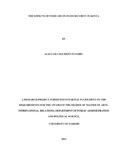| dc.description.abstract | The objective of the research was to thematically investigate the effects that food aid has on
food security in Kenya. Research methodology utilised in this study was descriptive study,
which was useful in analyzing the large quantity of data collected over a long period of time
(years 2006 -2012) by WFP, NDMA and KFSSG. Descriptive study was helpful in analyzing
the events and trends that influence food insecurity in Kenya and the conditions that guide
food aid distribution in the country. The population of study was made up of18 counties that
suffer from insecurity in Kenya, that live in different livelihood zones in the ASAL region in
Kenya. The sampling technique used was purposive which enabled the research to focus on
counties that have different livelihood zones in the ASAL region. Secondary was collected
and analysed through the use of content analysis. It was then represented and interpreted by
employing the use of histograms, graph and pie charts.
The study concluded that there is a relationship between food aid and food security in Kenya.
The country receives more bilateral aid than multilateral aid. Also the type of food aid
distributed most in Kenya is emergency food aid. Kenya as a country has a higher number of
bilateral food aid donors than multilateral donors. There is an over reliance on traditional
modes of agriculture in Kenya. Agriculture in Kenya is also greatly reliant on seasonal
rainfall that has failed to foster local food production adequately. Additionally, food aid had
been seen to have an effect on the market trends of locally available food especially at the
county level. The study also recommended that for the effective management of food
insecurity Kenya, the stakeholders of food security should increase their efforts in areas of
scientific food research and in policy values that govern food security in the country. This
will in turn help to alleviate the country’s dependency on food aid and foster positive long
term solutions to food security. | en_US |

